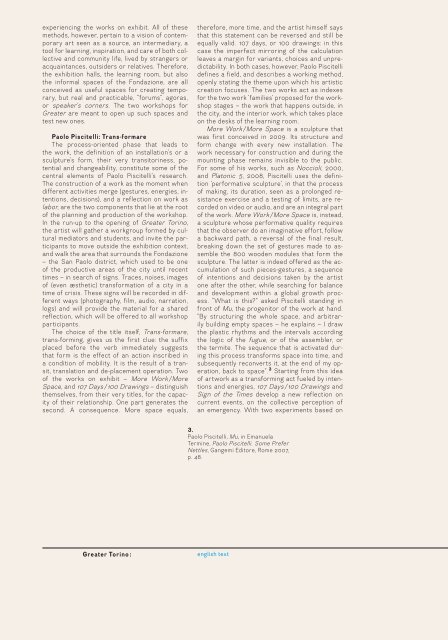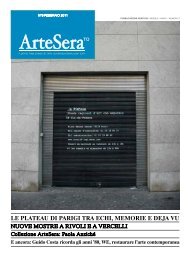Download Catalogue - Paola Anziché
Download Catalogue - Paola Anziché
Download Catalogue - Paola Anziché
You also want an ePaper? Increase the reach of your titles
YUMPU automatically turns print PDFs into web optimized ePapers that Google loves.
experiencing the works on exhibit. All of these<br />
methods, however, pertain to a vision of contemporary<br />
art seen as a source, an intermediary, a<br />
tool for learning, inspiration, and care of both collective<br />
and community life, lived by strangers or<br />
acquaintances, outsiders or relatives. Therefore,<br />
the exhibition halls, the learning room, but also<br />
the informal spaces of the Fondazione, are all<br />
conceived as useful spaces for creating temporary,<br />
but real and practicable, “forums”, agoras,<br />
or speaker’s corners. The two workshops for<br />
Greater are meant to open up such spaces and<br />
test new ones.<br />
Paolo Piscitelli: Trans-formare<br />
The process-oriented phase that leads to<br />
the work, the definition of an installation’s or a<br />
sculpture’s form, their very transitoriness, potential<br />
and changeability, constitute some of the<br />
central elements of Paolo Piscitelli’s research.<br />
The construction of a work as the moment when<br />
different activities merge (gestures, energies, intentions,<br />
decisions), and a reflection on work as<br />
labor, are the two components that lie at the root<br />
of the planning and production of the workshop.<br />
In the run-up to the opening of Greater Torino,<br />
the artist will gather a workgroup formed by cultural<br />
mediators and students, and invite the participants<br />
to move outside the exhibition context,<br />
and walk the area that surrounds the Fondazione<br />
– the San Paolo district, which used to be one<br />
of the productive areas of the city until recent<br />
times – in search of signs. Traces, noises, images<br />
of (even æsthetic) transformation of a city in a<br />
time of crisis. These signs will be recorded in different<br />
ways (photography, film, audio, narration,<br />
logs) and will provide the material for a shared<br />
reflection, which will be offered to all workshop<br />
participants.<br />
The choice of the title itself, Trans-formare,<br />
trans-forming, gives us the first clue: the suffix<br />
placed before the verb immediately suggests<br />
that form is the effect of an action inscribed in<br />
a condition of mobility. It is the result of a transit,<br />
translation and de-placement operation. Two<br />
of the works on exhibit – More Work / More<br />
Space, and 107 Days / 100 Drawings – distinguish<br />
themselves, from their very titles, for the capacity<br />
of their relationship. One part generates the<br />
second. A consequence. More space equals,<br />
Greater Torino :<br />
therefore, more time, and the artist himself says<br />
that this statement can be reversed and still be<br />
equally valid. 107 days, or 100 drawings: in this<br />
case the imperfect mirroring of the calculation<br />
leaves a margin for variants, choices and unpredictability.<br />
In both cases, however, Paolo Piscitelli<br />
defines a field, and describes a working method,<br />
openly stating the theme upon which his artistic<br />
creation focuses. The two works act as indexes<br />
for the two work ‘families’ proposed for the workshop<br />
stages – the work that happens outside, in<br />
the city, and the interior work, which takes place<br />
on the desks of the learning room.<br />
More Work / More Space is a sculpture that<br />
was first conceived in 2009. Its structure and<br />
form change with every new installation. The<br />
work necessary for construction and during the<br />
mounting phase remains invisible to the public.<br />
For some of his works, such as Noccioli, 2000,<br />
and Platonic 5, 2008, Piscitelli uses the definition<br />
‘performative sculpture’, in that the process<br />
of making, its duration, seen as a prolonged resistance<br />
exercise and a testing of limits, are recorded<br />
on video or audio, and are an integral part<br />
of the work. More Work / More Space is, instead,<br />
a sculpture whose performative quality requires<br />
that the observer do an imaginative effort, follow<br />
a backward path, a reversal of the final result,<br />
breaking down the set of gestures made to assemble<br />
the 800 wooden modules that form the<br />
sculpture. The latter is indeed offered as the accumulation<br />
of such pieces-gestures, a sequence<br />
of intentions and decisions taken by the artist<br />
one after the other, while searching for balance<br />
and development within a global growth process.<br />
“What is this?” asked Piscitelli standing in<br />
front of Mu, the progenitor of the work at hand.<br />
“By structuring the whole space, and arbitrarily<br />
building empty spaces – he explains – I draw<br />
the plastic rhythms and the intervals according<br />
the logic of the fugue, or of the assembler, or<br />
the termite. The sequence that is activated during<br />
this process transforms space into time, and<br />
subsequently reconverts it, at the end of my operation,<br />
back to space”. 3 Starting from this idea<br />
of artwork as a transforming act fueled by intentions<br />
and energies, 107 Days / 100 Drawings and<br />
Sign of the Times develop a new reflection on<br />
current events, on the collective perception of<br />
an emergency. With two experiments based on<br />
3.<br />
Paolo Piscitelli, Mu, in Emanuela<br />
Termine, Paolo Piscitelli. Some Prefer<br />
Nettles, Gangemi Editore, Rome 2007,<br />
p. 48.<br />
english text



